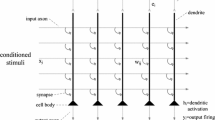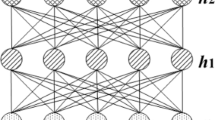Abstract
A sparse two-Dimension distance weighted approach for improving the performance of exponential correlation associative memory (ECAM) and modified exponential correlation associative memory (MECAM) is presented in this paper. The approach is inspired by biological visual perception mechanism and extensively existing sparse small-world network phenomenon. By means of the approach, the two new associative memory neural networks, i.e., distance-based sparse ECAM (DBS-ECAM) and distance-based sparse MECAM (DBS-MECAM), are induced by introducing both the decaying two-Dimension distance factor and small-world architecture into ECAM and MECAM’s evolution rule for image processing application. Such a new configuration can reduce the connection complexity of conventional fully connected associative memories so that makes AM’ VLSI implementation easier. More importantly, the experiments performed on the binary visual images show DBS-ECAM and DBS-MECAM can learn and recognize patterns more effectively than ECAM and MECAM, respectively.
Similar content being viewed by others
References
Haykin, S. Neural Networks: A Comprehensive Foundation, 2nd ed, Englewood Cliffs, NJ, Prentice-Hall, 1999.
Hopfield J.J. (1982), Neural network and physical systems with emergent collective computational abilities. Proceeding of the National Academic Science USA 79, 2554–2558
McEliece R.J., Posner E.C., Rodemich E.R., Venkatesh S.S. (1987), The capacity of the Hopfield associative memory. IEEE Transaction Information Theory IT-33, 461–482
Psaltis D., Park C.H. (1986). Nonlinear discriminant functions and associative memories. In: Denker J.S. (eds). Neural Networks for Computing. American Institute of Physics, New York, NY, pp. 370–375
Dembo A., Zeitouni O. (1988). High density associative memories. In: Anderson D.Z. (eds). Neural Information Processing Systems. American Institute of Physics, New York, NY, pp. 211–218
Dembo A., Zeitouni O. (1988), General potential surfaces and neural networks. Physics Review A 37(6): 2134–2143
Sayeh, M. R. and Han, J. Y. Pattern recognition using a neural network, In: Proceeding SPIE Cambridge Symposium Optics and Optoelectronics Engineering Cambridge, MA, 1987.
Chiueh T.D., Goodman R.M. (1991), Recurrent correlation associative memories. IEEE Transactions on Neural Networks 2(2): 275–284
Chiueh T.D., Tsai H.K. (1993), Multivalued associative memories based on recurrent networks. IEEE Transactions on Neural Networks 4(2): 364–366
Chen, Z. Y. and Kwong, C. P. Recurrent correlation associative memories with multiple-value, In: Proceedings of IEEE International Conference Neural Networks, pp.1068–1073, 1994.
Kosko B. (1988), Bidirectional associative memories. IEEE Transactions on System, Man and Cybernetics 18(1): 49–60
Tai H.M. (1989), High-order bidirectional associative memory. Electronics Letters 25: 1424–1425
Jeng Y.J., Yeh C.C., Chiueh T.D. (1991), Exponential bidirectional associative memories. IEEE Transactions Neural Networks 2: 275–284
Chen S.C., Gao H., Yan W. (1997), Improved exponential associative memory. Electronics Letters 33: 223–224
Kohonen T. (1997). Self-Organizing Maps, 2nd edn, Springer-Verlag, Berlin
Watts D.J., Strogatz S.H. (1998), Collective dynamics of ‘small-world’ networks. Nature 393: 440–442
Moon S.W., Kong S.G. (2001), Block-based neural networks. IEEE Transaction on Neural Networks 12(2): 307–317
Seow M.J., Asari V.K. (2004), Learning using distance based training algorithm for pattern recognition. Pattern Recognition Letters 25(2): 189–196
Venkatesh S. (1992), Robustness in neural computation: random graphs and sparsity. IEEE Transactions Information Theory 38, 1114–1119
McGraw P.J., Mezinger M. (2003), Topology and computational performance of attractor neural networks. Physical Review E 68: 047102
Kim B.J. (2004), Performance of networks of artificial neurons the role of clustering. Physical Review E 69: 045101
Torres J.J., Munoz M.A., Marro J., Garrido P.L. Influence of topology on the performance of a neural network. Neurocomputing 58–60 (2004), 229–234.
Bohland, J. W. and Minai, A. A. Efficient associative memory using small-world structure, Neurocomputing 38–40 (2001), 489–496.
Milgram S. (1967), The small-world problem. Psychological Today 2: 60–67
Author information
Authors and Affiliations
Corresponding author
Rights and permissions
About this article
Cite this article
Chen, L., Chen, S. Distance-Based Sparse Associative Memory Neural Network Algorithm for Pattern Recognition. Neural Process Lett 24, 67–80 (2006). https://doi.org/10.1007/s11063-006-9012-y
Published:
Issue Date:
DOI: https://doi.org/10.1007/s11063-006-9012-y




